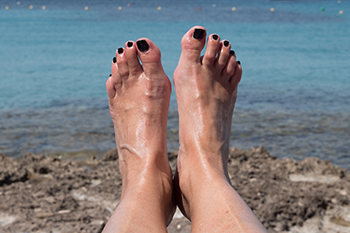
There are several troublesome rare diseases that can negatively impact the health of your feet. Although these conditions can be extremely rare, it is important for you to familiarize yourself with these afflictions in case you ever have to identify one of these conditions in yourself or a loved one. One rare condition that negatively impacts the feet is known as Maffucci syndrome, which has only impacted a total of 200 reported patients since its discovery. This syndrome produces a number of abnormalities in the skeleton that can manifest themselves in the feet. For example, people with Maffucci syndrome can experience enchondromas, which are cartilage tumors throughout the bones in their feet. Endochromas caused by Maffucci syndrome can also appear in the hands, ribs, and skull. Individuals suffering from Maffucci syndrome usually also experience some kind of abnormality in the skin. Namely, it is common for individuals to see hemangiomas, or clumps of blood vessels, throughout the skin and possibly on the feet. Maffucci syndrome undoubtedly is a rare condition, but you should be on the lookout for these symptoms. If you are experiencing the above symptoms, or would like to gather more information, it is suggested to speak to a podiatrist.
Some foot conditions may require additional professional care. If you have any concerns, contact one of our podiatrists of InStride Family Foot Care. Our doctors can provide the care you need to keep you pain-free and on your feet.
Rare Foot Conditions
The majority of foot conditions are common and can be treated by a podiatrist. Standard diagnostic procedures are generally used to identify specific conditions and treatment can be rendered. A podiatrist also treats rare foot conditions which can be difficult to diagnose and may need extra attention and care.
There are many rare foot conditions that can affect children. Some of these can include:
- Freiberg’s disease
- Kohler’s disease
- Maffucci syndrome
Freiberg’s disease - This can be seen as a deterioration and flattening of a metatarsal bone that exists in the ball of the foot. It typically affects pre-teen and teenage girls, but can affect anyone at any age. Symptoms that can accompany this can be swelling, stiffness, and the patient may limp.
Kohler’s disease - This often targets the bone in the arch of the foot and affects younger boys. It can lead to an interruption of the blood supply which ultimately can lead to bone deterioration. The patient may limp or experience tenderness, swelling, and redness.
Maffucci syndrome - This affects the long bones in a child’s foot leading to the development of abnormal bone lesions. They are benign growths and typically develop in early childhood and the bones may be susceptible to breaking.
A podiatrist can properly diagnose and treat all types of rare foot conditions. If your child is affected by any of these symptoms or conditions, please don’t hesitate to call our office so the correct treatment method can begin.
If you have any questions please feel free to contact our offices located in Concord, Charlotte, and Salisbury, NC . We offer the newest diagnostic tools and technology to treat your foot and ankle needs.




